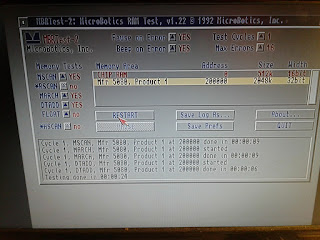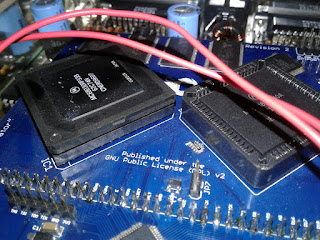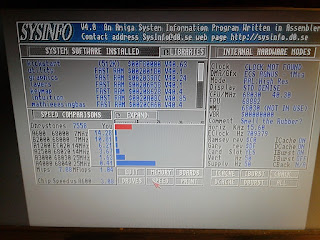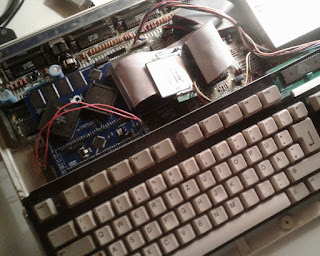Building the TerribleFire TF530 accelerator, part 6: Faster! Hotter!
With a little more experience and new information gained, there was something left to do...
Disclaimer: This is not an instruction. Use at your own risk. No responsibility taken for whatever you do. Safety first. Kids, dont try this at home.
32MHz might not be too shabby, but then it's a weird number, and the TF530 is capable of more. It's been quite some time since I built my TF530. In the meantime Mr. Leary has released new firmware versions, improving the accelerator's compatibility with higher clock rates (among other things, probably). So the day had come to try a little tweaking.
First of all I had to test the latest firmware release. I fired up my laptop running Xilinx's CPLD programming software, connected the USB-cable to one, and TF530 5V power input to another USB port on the laptop. Surprise: The Amiga boots! It pulls enough power from the laptop's USB port to boot to Workbench! And of course the laptop (running Windows) complains about a USB device pulling way too much power! Ok, I'd better disconnect the power, remove the TF530 from the Amiga, reconnect, and try again...
Faster!
Without any changes to the TF530 I uploaded the latest software to the CPLDs. Hm, not bad! Worked flawlessly, and SysInfo shows a little speed increase of about... 3%! Not precisely earth-shattering, but a welcome improvement.
 |
| From ~5800 Dhrystones to ~6000 just by firmware update! |
I had never thoroughly tested the memory chips, and the new firmware needed something to do, so I started Microbotic's excellent MBRTest-2 memory testing program, and ran a couple of tests. To my surprise there were no errors - my handling and soldering of the memory chips was fine from day zero!
 |
| No RAM errors, very good! |
So far, so - very - good. I had seen some accelerator configurations where the 68030 had been overclocked by about 25%, and the FPU on my TF530 is a 40Mhz model anyway, so, yeah, why not try 40Mhz on the 33Mhz CPU?
 |
| 33Mhz CPU and 40MHZ FPU - will they run fine at 40MHz? |
Replacing the tiny SMD type 32Mhz oscillator with a 40Mhz one requires some fiddling if you don't have a heat-gun, but these oscillators seem to be quite tolerant to heat, and I managed to do it using a soldering-iron without any visible damage. After some cleaning it was time to switch the Amiga on, and see how she does...
 |
| ~7500 Dhrystones! |
Hotter!
Once again, to my surprise, this worked flawlessly! Wow, running at 40Mhz we get about 7500 Dhrystones in SysInfo! The 68030 is getting a bit hot - I'll be adding at least a small heatsink just to avoid unnecessary stress on the material.
 |
| TerribleFire 530 with CF card adaptor inside the "Amiga 530" |
As a final touch to my "Amiga 530" I wanted to delete AmigaOS3.9 from the CF card, and reinstall OS3.1. With some little adjustments OS3.9 ran quite well on the machine, but it's still comparatively resource-hungry, and in some parts unnecessarily bloated, thus slow. Installation of OS3.1 - no surprise here - was quick and worked flawlessly, too. Another reset, and...
...the Amiga now boots to Workbench in about 9 seconds!
This is really good. I could try to get a 50Mhz CPU and install a 50Mhz oscillator - the 40Mhz FPU should be able to take that (the 33MHz CPU probably not so much...) - but for now I'm really perfectly satisfied with the performance. Firmware update, plus faster clock, plus operating system downgrade really make a difference. I'm assuming an added heat-sink will make the setup safe and stable in the long term.
Now will THIS be the last part of the series of articles about "Building the TerribleFire TF530 accelerator"? Who knows. Probably not! There's still so much to experiment with - we haven't even touched the SPI port yet!
Once again a huge Thank You! to Mr. Stephen Leary for developing and releasing this awesome accelerator!
http://amigaalive.blogspot.de/p/hardware-building-terribefire-tf530.html
